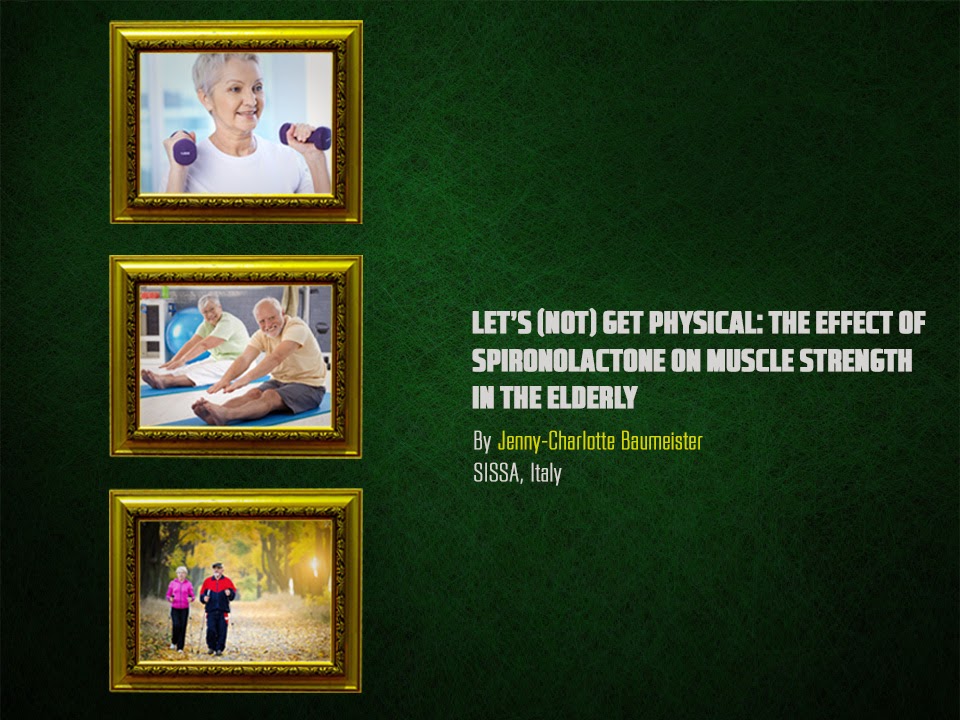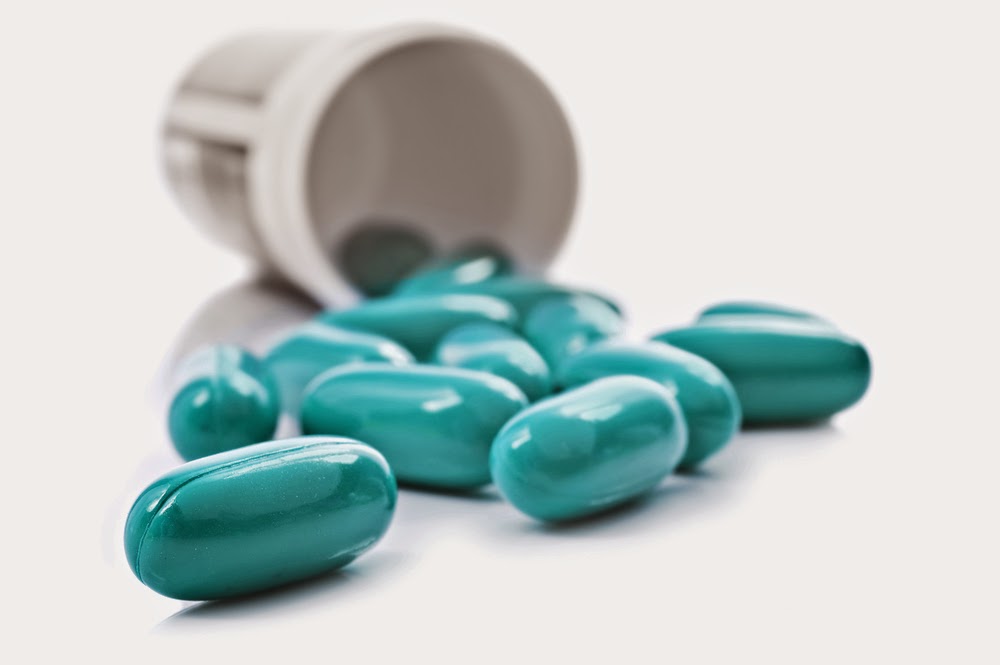Image Source: Serial/Trash
Life expectancy has increased
continuously over the past several decades, and with it, a host of new
age-related ailments have emerged as contemporary medical issues. Muscle
function decreases with age, leaving increasing numbers of elderly people
incapable of being physically independent. This not only has devastating personal
effects but is also a major public health issue. In a recent study, researchers
investigated whether blocking the hormone aldosterone may help counter the
effects of physical impairment with age.
continuously over the past several decades, and with it, a host of new
age-related ailments have emerged as contemporary medical issues. Muscle
function decreases with age, leaving increasing numbers of elderly people
incapable of being physically independent. This not only has devastating personal
effects but is also a major public health issue. In a recent study, researchers
investigated whether blocking the hormone aldosterone may help counter the
effects of physical impairment with age.
Aldosterone is a hormone
best known from the role it plays in the regulation of blood pressure, but it has
also been associated with muscle weakness. This makes sense, considering that aldosterone
also lowers levels of magnesium and potassium – two minerals that are essential
for muscle contractility. Thus lower levels of aldosterone may promote
restoring muscle function.
best known from the role it plays in the regulation of blood pressure, but it has
also been associated with muscle weakness. This makes sense, considering that aldosterone
also lowers levels of magnesium and potassium – two minerals that are essential
for muscle contractility. Thus lower levels of aldosterone may promote
restoring muscle function.
How can we keep aldosterone levels
low? The production of aldosterone in the body is a complex interplay between
hormones and enzymes. Medication can be targeted to interfere with it at
different stages. One way to influence aldosterone levels is to inhibit the creation
of a hormone that would otherwise stimulate its production. These so-called angiotensin-converting
enzyme blockers (ACE blockers) are usually prescribed to treat high blood pressure
and heart failure. Interestingly, some studies reported additional positive
effects on muscle strength and physical fitness in elderly. But the results not conclusive: some studies did
not find any positive effect on muscle strength. Furthermore, ACE blockers seem
to fail at reducing aldosterone levels over longer time periods. However, long-term
efficacy is a crucial factor for improving muscle function.
low? The production of aldosterone in the body is a complex interplay between
hormones and enzymes. Medication can be targeted to interfere with it at
different stages. One way to influence aldosterone levels is to inhibit the creation
of a hormone that would otherwise stimulate its production. These so-called angiotensin-converting
enzyme blockers (ACE blockers) are usually prescribed to treat high blood pressure
and heart failure. Interestingly, some studies reported additional positive
effects on muscle strength and physical fitness in elderly. But the results not conclusive: some studies did
not find any positive effect on muscle strength. Furthermore, ACE blockers seem
to fail at reducing aldosterone levels over longer time periods. However, long-term
efficacy is a crucial factor for improving muscle function.
Image Source: Shutterstock Copyright: Tish1
Another way to interfere
with aldosterone is to block aldosterone receptors directly. This is exactly
what a drug called spironolactone does. It blocks receptors in the kidneys,
heart and blood vessels that are usually targeted by aldosterone. Because aldosterone
can only act when it has the possibility to bind to its receptors, any competition
for those receptors blocks its action. Recent studies suggest however that
blocking the aldosterone receptors by means of spironolactone may be superior
to ACE inhibitors when it comes to blocking the specific effects of
aldosterone. For example, spironolactone seems to be more effective than ACE
inhibitors in keeping magnesium and potassium levels in muscles high – a highly
desired effect for improving muscle strength. Spironolactone may thus be a
promising medication to counter the decline in muscle function in elderly.
with aldosterone is to block aldosterone receptors directly. This is exactly
what a drug called spironolactone does. It blocks receptors in the kidneys,
heart and blood vessels that are usually targeted by aldosterone. Because aldosterone
can only act when it has the possibility to bind to its receptors, any competition
for those receptors blocks its action. Recent studies suggest however that
blocking the aldosterone receptors by means of spironolactone may be superior
to ACE inhibitors when it comes to blocking the specific effects of
aldosterone. For example, spironolactone seems to be more effective than ACE
inhibitors in keeping magnesium and potassium levels in muscles high – a highly
desired effect for improving muscle strength. Spironolactone may thus be a
promising medication to counter the decline in muscle function in elderly.
In line with this, physical
fitness of heart failure patients improves after they’re treated with spironolactone.
However, one must consider that spironolactone is well-known as an effective
medication for high blood pressure and heart failure. Therefore, its positive
effect on physical performance may simply be caused by better overall health
after treatment rather than by a direct effect of spironolactone on muscle
strength. To understand whether the intake of spironolactone may have a
beneficial effect on muscle strength in elderly who do not suffer from heart
failure, a research team from the University of Dundee recruited 120 patients aged
65 and older. The patients had self-reported difficulties in performing daily
activities, but did not suffer from heart conditions or high blood pressure.
Half of the participants received a daily dose of spironolactone over a period
of 20 weeks, while the other half of the patient group received a placebo – a
pill that resembled spironolactone but which was medically inert. The
researchers considered various factors of interest, including objective and subjective
physical function. Subjective physical functioning was measured by self-reports.
Objective physical function was assessed by the distance that participants
could walk within 6 minutes, a simple but widely-used, reliable measure of exercise
performance in the elderly.
fitness of heart failure patients improves after they’re treated with spironolactone.
However, one must consider that spironolactone is well-known as an effective
medication for high blood pressure and heart failure. Therefore, its positive
effect on physical performance may simply be caused by better overall health
after treatment rather than by a direct effect of spironolactone on muscle
strength. To understand whether the intake of spironolactone may have a
beneficial effect on muscle strength in elderly who do not suffer from heart
failure, a research team from the University of Dundee recruited 120 patients aged
65 and older. The patients had self-reported difficulties in performing daily
activities, but did not suffer from heart conditions or high blood pressure.
Half of the participants received a daily dose of spironolactone over a period
of 20 weeks, while the other half of the patient group received a placebo – a
pill that resembled spironolactone but which was medically inert. The
researchers considered various factors of interest, including objective and subjective
physical function. Subjective physical functioning was measured by self-reports.
Objective physical function was assessed by the distance that participants
could walk within 6 minutes, a simple but widely-used, reliable measure of exercise
performance in the elderly.
The results were surprising:
the treatment with spironolactone did not increase the distance that participants
could walk within 6 minutes, suggesting that the intake of spironolactone did not
enhance their muscle functioning. In contrast to the objective findings, the
self-report measures showed another picture: after 20 weeks, only those participants
who had been treated with spironolactone reported an improvement in quality of
life. Whether this effect was caused by a pain-relieving effect or by other
pharmacological benefits associated with spironolactone is not known; further
studies are required to clarify these results.
the treatment with spironolactone did not increase the distance that participants
could walk within 6 minutes, suggesting that the intake of spironolactone did not
enhance their muscle functioning. In contrast to the objective findings, the
self-report measures showed another picture: after 20 weeks, only those participants
who had been treated with spironolactone reported an improvement in quality of
life. Whether this effect was caused by a pain-relieving effect or by other
pharmacological benefits associated with spironolactone is not known; further
studies are required to clarify these results.
Despite the fact that the
results could not confirm any positive effect of spironolactone on muscle
strength, this should not be interpreted as a definite exclusion of its efficacy
as a counteragent for age-related muscle decline. Rather, the findings
demonstrate that spironolactone was well tolerated in participants without
heart failure and improved their quality of life. This provides encouragement
to test the drug at higher doses and for longer treatment durations. Future
studies are needed to determine whether these advanced treatments can cause the
desired physiological effects, but the current findings help to define them.
results could not confirm any positive effect of spironolactone on muscle
strength, this should not be interpreted as a definite exclusion of its efficacy
as a counteragent for age-related muscle decline. Rather, the findings
demonstrate that spironolactone was well tolerated in participants without
heart failure and improved their quality of life. This provides encouragement
to test the drug at higher doses and for longer treatment durations. Future
studies are needed to determine whether these advanced treatments can cause the
desired physiological effects, but the current findings help to define them.
This summary by Jenny-Charlotte Baumeister was shortlisted for Access to Understanding 2014 and was commended by the judges. It describes research published in the following article, selected for inclusion in the competition by the Chief Scientist Office of the Scottish Executive:
PMCID: PMC3695565
L.A. Burton, D. Sumukadas, M.D. Witham, A.D. Struthers & M.E.T. McMurdo.
The American Journal of Medicine (2013) 126(7), 590-597.
Access to Understanding entrants are asked to write a plain English summary of a research article. For Access to Understanding 2014 there were 10 articles to choose from, selected by the Europe PMC funders. The articles are all available from Europe PMC, are free to read and download, and were supported by one or more of the Europe PMC funders.
Look out here and on Twitter @EuropePMC_news for further competition news and other Europe PMC announcements.






Interesting summary. Hope this can pave the way for new types of treatment for physical impairment in the elderly. The patient's own subjective sense of wellness can directly affect longevity as well as quality of life.